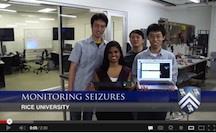 According to a press release, engineering students at Rice University have created a belt that monitors signs of epileptic seizures and sends information to the caregiver’s bedside. This epileptic seizure belt could be a great help, especially for parents monitoring their children at night.
According to a press release, engineering students at Rice University have created a belt that monitors signs of epileptic seizures and sends information to the caregiver’s bedside. This epileptic seizure belt could be a great help, especially for parents monitoring their children at night.
“The belt detects increased electrical conductance in the skin and changes in respiration rate, both signs that a seizure is underway. Though children or adults can wear the belt, the students designed it with kids in mind. They want parents to be aware of when a child is having a seizure, especially during the night.”
Known as the SMART belt, which stands for Seizure Monitoring and Response Transducer, has two silver/silver chloride electrodes, like those used in lie detectors, positioned on the torso which sense electrical conductivity. Another sensor also monitors breathing and when the sensors show signs of a seizure, the transmitter sends data via Bluetooth to either a computer or smartphone.
“Our belt is targeted for ages 6 years and up,” Varughese said. “It works best during the nighttime because there’s not a lot of other stimuli, and we can definitely detect changes in the two signs.”
The SMART belt was designed to be an inexpensive, comfortable device that could be worn around the clock under a patient’s clothes. In addition to its ability to monitor and alert when seizures occur, the SMART belt is also able to compile a record of seizure occurrences which can be shared with the individual’s doctor.
Current methods of epileptic seizure monitoring by parents include bed-vibration sensors which detect convulsions that occur in 20 percent of epileptic seizures. Unfortunately, these devices are prone to false positives, which can lead parents to begin ignoring the alerts. “You don’t want parents waking up too frequently, or they won’t use the device,” said Tiffany Varughese, a member of development team – ‘Team Seize and Assist.’
Watch a video demonstration of the SMART belt, epilepsy monitoring and alert system here:
Other members of the team include Ethan Leng, Mihir Mongia, Charles Park, and Andrew Wu, who built the belt as their senior capstone design project, required of most Rice engineering students. The team hopes to offer help to the estimated 2.3 million people with epilepsy in the United States with their design. “The main goal of our project was to build the sensors and demonstrate that they work, and show they have the potential to detect seizures,” Park said.
Development of the SMART belt was sponsored by Cyberonics Inc., a Houston-based medical device company, while the engineering team was advised by Gary Woods, a Rice professor in the practice of computer technology and electrical and computer engineering.
![Herbal Reference Substances are Key to Everyday Products <!-- AddThis Sharing Buttons above -->
<div class="addthis_toolbox addthis_default_style " addthis:url='http://newstaar.com/herbal-reference-substances-are-key-to-everyday-products/3512112/' >
<a class="addthis_button_facebook_like" fb:like:layout="button_count"></a>
<a class="addthis_button_tweet"></a>
<a class="addthis_button_pinterest_pinit"></a>
<a class="addthis_counter addthis_pill_style"></a>
</div>When it comes to quality control testing and the development of new products, Botanical Reference Materials (BRMs), also known as Herbal References are critically important. To help companies ultimately obtain all-important FDA approval, the Food and Drug Administration provides in its guidance a recommendation that […]<!-- AddThis Sharing Buttons below -->
<div class="addthis_toolbox addthis_default_style addthis_32x32_style" addthis:url='http://newstaar.com/herbal-reference-substances-are-key-to-everyday-products/3512112/' >
<a class="addthis_button_preferred_1"></a>
<a class="addthis_button_preferred_2"></a>
<a class="addthis_button_preferred_3"></a>
<a class="addthis_button_preferred_4"></a>
<a class="addthis_button_compact"></a>
<a class="addthis_counter addthis_bubble_style"></a>
</div>](http://newstaar.com/wp-content/uploads/2021/02/Achillea_millefolium_flowers-100x100.jpg)
![Quality Electrochemical Biosensors are Critical for Medical, Food and Chemical Industry <!-- AddThis Sharing Buttons above -->
<div class="addthis_toolbox addthis_default_style " addthis:url='http://newstaar.com/quality-electrochemical-biosensors-are-critical-for-medical-food-and-chemical-industry/3512086/' >
<a class="addthis_button_facebook_like" fb:like:layout="button_count"></a>
<a class="addthis_button_tweet"></a>
<a class="addthis_button_pinterest_pinit"></a>
<a class="addthis_counter addthis_pill_style"></a>
</div>A number of industries have, at their core, a need to frequent or even continuous analysis of biological media. These include the medical and pharmaceutical fields, biotech firms, and food and chemical companies. To maintain quality standards and develop new products, these industries rely heavily […]<!-- AddThis Sharing Buttons below -->
<div class="addthis_toolbox addthis_default_style addthis_32x32_style" addthis:url='http://newstaar.com/quality-electrochemical-biosensors-are-critical-for-medical-food-and-chemical-industry/3512086/' >
<a class="addthis_button_preferred_1"></a>
<a class="addthis_button_preferred_2"></a>
<a class="addthis_button_preferred_3"></a>
<a class="addthis_button_preferred_4"></a>
<a class="addthis_button_compact"></a>
<a class="addthis_counter addthis_bubble_style"></a>
</div>](http://newstaar.com/wp-content/uploads/2020/10/Electrochemical-Biosensor-100x100.jpg)
![Company Develops Industrial Mixers Well-Suited for both Fragile and Explosive Products <!-- AddThis Sharing Buttons above -->
<div class="addthis_toolbox addthis_default_style " addthis:url='http://newstaar.com/company-develops-industrial-mixers-well-suited-for-both-fragile-and-explosive-products/3512071/' >
<a class="addthis_button_facebook_like" fb:like:layout="button_count"></a>
<a class="addthis_button_tweet"></a>
<a class="addthis_button_pinterest_pinit"></a>
<a class="addthis_counter addthis_pill_style"></a>
</div>Industrial drum mixers are normally applied to blend mixes of varying viscosities such as adhesive slurries or cement. Some of these mixers have the capability of blending mixes of very different particle sizes such as fruit and ice cream, and gravel and cement slurry. The […]<!-- AddThis Sharing Buttons below -->
<div class="addthis_toolbox addthis_default_style addthis_32x32_style" addthis:url='http://newstaar.com/company-develops-industrial-mixers-well-suited-for-both-fragile-and-explosive-products/3512071/' >
<a class="addthis_button_preferred_1"></a>
<a class="addthis_button_preferred_2"></a>
<a class="addthis_button_preferred_3"></a>
<a class="addthis_button_preferred_4"></a>
<a class="addthis_button_compact"></a>
<a class="addthis_counter addthis_bubble_style"></a>
</div>](http://newstaar.com/wp-content/uploads/2020/06/bandeau-sofragir2-100x100.jpg)